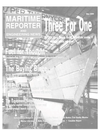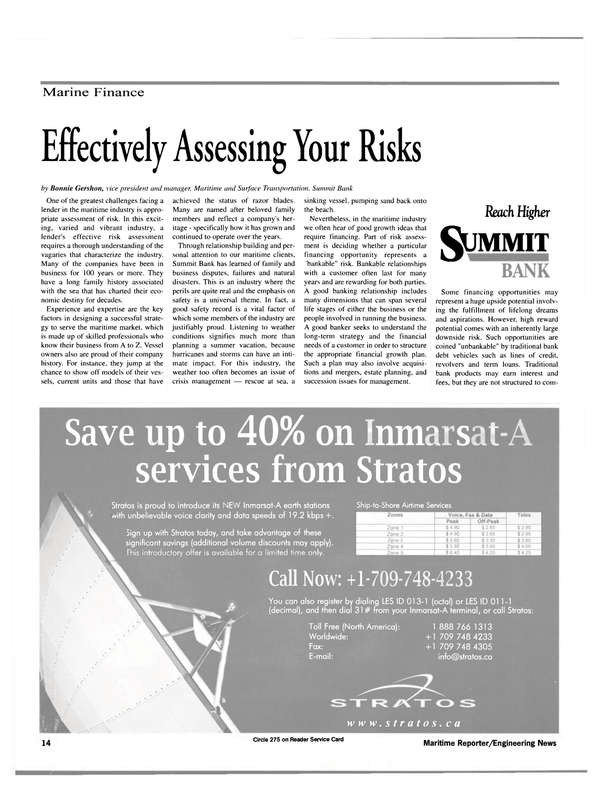
Reach Higher Summit Bank
Some financing opportunities may represent a huge upside potential involving the fulfillment of lifelong dreams and aspirations. However, high reward potential comes with an inherently large downside risk. Such opportunities are coined "unbankable" by traditional bank debt vehicles such as lines of credit, revolvers and term loans. Traditional bank products may earn interest and fees, but they are not structured to com- pensate for these potential downside risks. Specifically, they are not structured to share in the financial upside of the project if, or when, the owners succeed in the business venture. These opportunities may, instead, represent a risk that is more appropriately funded with equity from investors, or through a private placement or other capital market services.
Let's say a banker makes a loan for $1 million. If that loan becomes uncollectible and deemed a write off, it will take $50 million at a two percent spread over a one-year period to make up the difference. An offset of this magnitude represents a costly mistake in risk management.
The duration of a loan is another factor in assessing risk. The longer the term, the greater the risk. Part of a banker's job is to match loan repayment with the appropriate asset life and cash flow. Generally, it is more beneficial to finance short-term assets with a shortterm loan or line of credit, or to finance longer-term assets with term debt. However, some of the equipment used in the marine industry has a very long asset life. In these cases, a bank may seek to limit the risk imposed by a lengthy amortization requirement with a shortterm balloon payment.
Maritime companies have financing needs that are unique. Their needs may be substantially large due to a variety of circumstances: the necessity to enlarge the fleet with new or used vessels; acquisition of another company; or a greater loan than the bank will normally finance. Under these circumstances, it may be appropriate for the customer's lead bank to arrange a "club" or "syndicated" loan. A club loan is usually a loan held by two to three banks. A syndicated loan may be larger in size and include up to 10 banks or more in the group.
Customarily, maritime customers use sophisticated capital markets products to finance various long-term growth opportunities. Privately placed longterm mezzanine loan and/or equity can be used to support a management buyout, a large acquisition or other substantial financing needs. Longer-term debt and equity can help a business weather a downturn.
For maritime business success, bankers must be aware of the uniqueness of the industry and determine what is a "bankable" deal in order to effectively meet the important challenge of correctly assessing and managing risk.
Summit Bank's Marine and Surface Transportation (MAST) group offers specialized lending expertise to companies within the maritime and transportation industries, as well as a full range of financial services, including equipment leasing, cash management and personal banking. A division of Summit Commercial, MAST focuses exclusively on serving the needs of maritime customers in this specialized industry by providing the experience, resources and flexibility to recommend the best industry-specific banking solutions that meet the company's strategic short and long term goals.
Circle 36 on Reader Service Card Summit Bank, a subsidiary of Summit Bancorp, is a financial services company headquartered in Princeton, New Jersey, with $36 billion in assets and $25 billion in deposits, it provides comprehensive financial services to an extensive retail, commercial and private banking customer base in New Jersey, Eastern Pennsylvania and Connecticut.
For additional information about the company, please visit its web site at www. summitbank. com
Read Reach Higher Summit Bank in Pdf, Flash or Html5 edition of May 2000 Maritime Reporter
Other stories from May 2000 issue
Content
- E-Utopia? page: 6
- Offshore Climbing Higher In Oslo page: 7
- Resilient Dutch Network page: 8
- New Runners From U.K. And Japanese Stables page: 10
- FGH Finalizes $40M Contracts page: 12
- Effectively Assessing Your Risks page: 14
- Reach Higher Summit Bank page: 14
- Coflexip Stena Awarded $58 Million Contract page: 16
- Congressional Maritime Legislative Initiatives In 2000 page: 20
- Spaarneborg Premieres As First Of Stora Enso's New Series page: 23
- MacGregor Outfits Advanced KHI-Built RoRo page: 26
- Eastern Builds Research Vessel For U of M page: 27
- Kvichak Supplies Patrol Vessel page: 29
- Trimaran Demonstrator Progressing At VT page: 32
- Alstom, USN Team For Integrated Solution page: 33
- MDI: Shipyard Production Expertise page: 34
- FR. Fassmer & Co.: Keeping It In The Family page: 35
- Wet Welding Provides More Than Quick Fix page: 36
- A New Wave of Customer-Driven Offerings: The SAGA Process page: 38
- Cost-Saving Coating Approved page: 40
- Kurz Joins Hvide As CEO page: 41
- Efficient Bunker Buyers "Need to Know" page: 42
- Online Fuel Supplier Fueled By Support page: 44
- Dylon Lubricant Develops Heavy Duty Grease page: 45
- Greek Ferries: The New Business Model page: 47
- Icy Wasteland Or Shipping Utopia? page: 55
- Specialties Cornerstone of Canadian Market page: 56
- Irving Shipbuilding Appoints New President page: 58
- Autoship, PAI Join Forces page: 58
- MV Paul J. Martin Christened At Port Weller page: 59
- Construction Contract Awarded For New Z-Drive Tug page: 59
- Fleet Technology Completes Option Study page: 60


